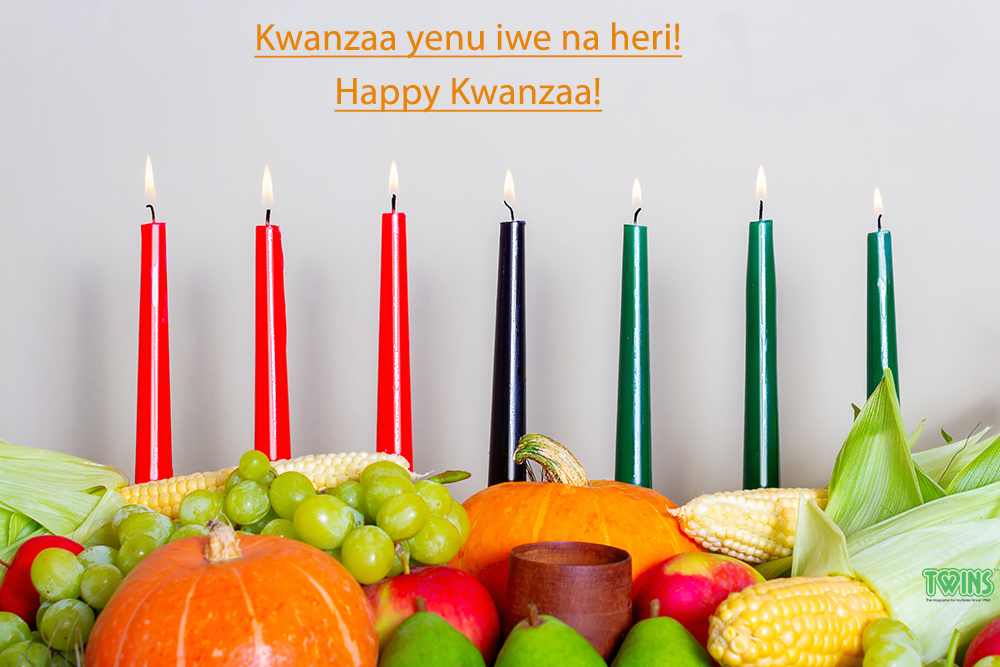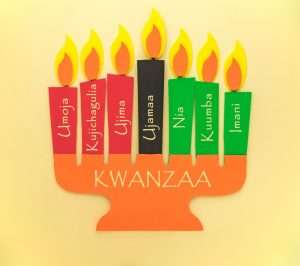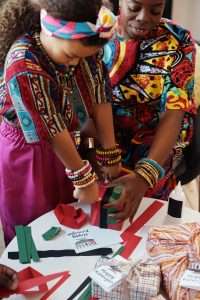Swahili – Kwanzaa yenu iwe na heri!
English – Happy Kwanzaa! Kwanzaa (kwahn-ZAH) or May your Kwanzaa be blessed
Kwanzaa is a 7-day celebration of community, family, culture, and values beginning December 26, culminating in a communal feast called Karamu. Established in 1966, the week-long celebration encourages African-Americans to reconnect with their African roots and heritage.
Although rooted in African culture, no matter your racial or ethnic background, join the celebration! Celebrate your roots with us this week!
How is Kwanzaa celebrated?
Kwanzaa is celebrated from December 26 to January 1. The term Kwanzaa is derived from the phrase “matunda ya kwanza” which means “first fruits” in Swahili.
Each day of Kwanzaa emphasizes a new principle, and the evening candle-lighting ceremony provides an opportunity to discuss each principle and its meaning.
Alongside the seven principles, Kwanzaa also has seven symbols:
- Mazao: The crops, such as fruits, vegetables, nuts.
- Mkeka: The placemat, made from straws or cloth.
- Vibunzi: Ear of corn, which means stalk of corn.
- Mishumaa Saba: The seven candles (preferably three green, three red, and one black.)
- Kinara: The candleholder.
- Kikombe Cha Umoja: The Unity Cup.
- Zawadi: Gifts.
The principles, called Nguzo Saba (seven principles in Swahili) are values of African culture. Here are the seven days and their principles.
Day 1: Umoja (Unity)
On this night, the black candle in the center is lit, and the first principle of Umoja (Unity) is discussed.
Unity reminds us that it’s important to stay united as a family, and as a community in the human race.
Day 2: Kujichagulia (Self-Determination)
On the second day of Kwanzaa, we celebrate the principle Kujichagulia, which is self-determination. The action of defining, naming, creating, and speaking for ourselves. It’s often a recurring theme between parents of multiples.
Emphasis is placed on the importance of each of us, as individuals, through self-empowerment and determination. There’s no question that twins offer a unique twist on how we approach self-empowerment. Here’s a bit more.
Day 3: Ujima (Collective Work and Responsibility)
On the third day, we celebrate the principle of Ujima, which is collective work and responsibility.
In these trying times, your kids will find it useful to know all about building and maintaining your community and working together, as a unit, to solve problems together. Being active in the community is a perfect way to honor your rich heritage.
Day 4: Ujamaa (Cooperative Economics)
The importance of Ujamaa lies in building and maintaining retail stores and other businesses, and profiting from these ventures. Everything we consume is meant to support family and our community. Look for opportunities to support your local businesses.
Day 5: Nia (Purpose)
The fifth principle, Nia, is purpose. As a unique group with a rich history, teaching your kids about their roots and how to exercise their purpose will help them build stronger communities. Get more perspective here.
Day 6: Kuumba (Creativity)
On this day, we light the 6th candle of Kwanzaa. We celebrate how we can channel our creative energies to help build and preserve a strong and vibrant community. We can do this through:
- gifting grandparents art made by our twins
- painting murals to beautify daycare/school walls
- cooking cultural foods or meals for our family and friends
- tending to family and community gardens
- sculpting statues of historical significance
Photo by Askar Abayev from Pexels
Day 7: Imani (Faith)
Last but not least, we have the final principle Imani, which is faith. The importance of Imani lies in the belief in God, family, heritage, leaders, and others that will lead to the victory and well-being of not just African Americans but all of us around the world.
Let’s teach our children to hold onto their beliefs and traditions to preserve them for the upcoming generations.
We hope you liked our Kwanzaa rundown! We provided a brief insight into the pillars that make it a celebration with a purpose. You can learn more about Kwanzaa and its rich history and roots here.




